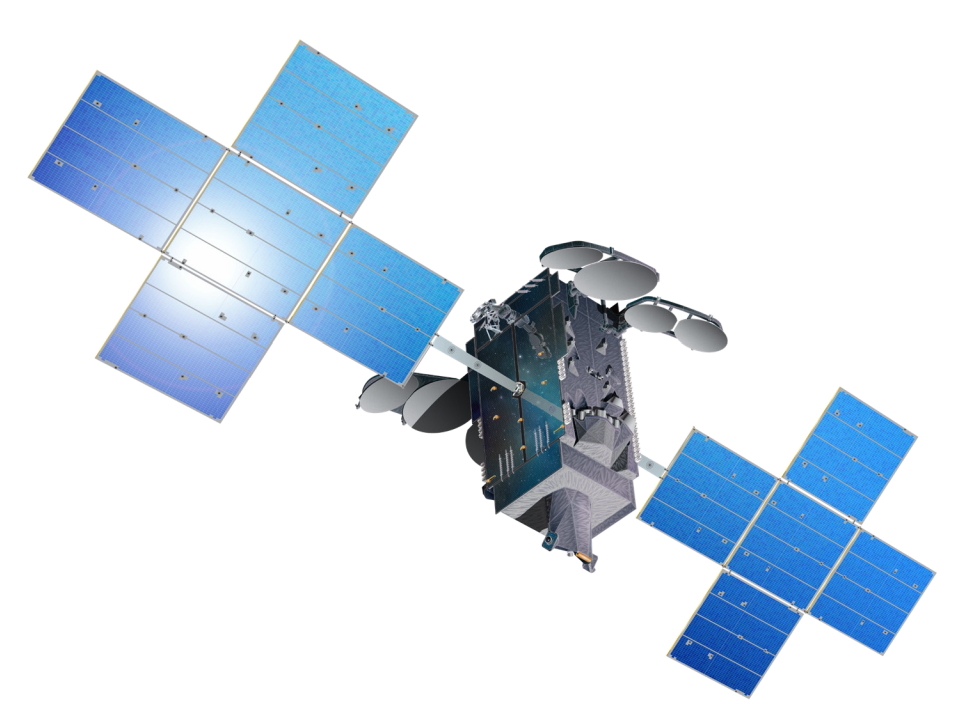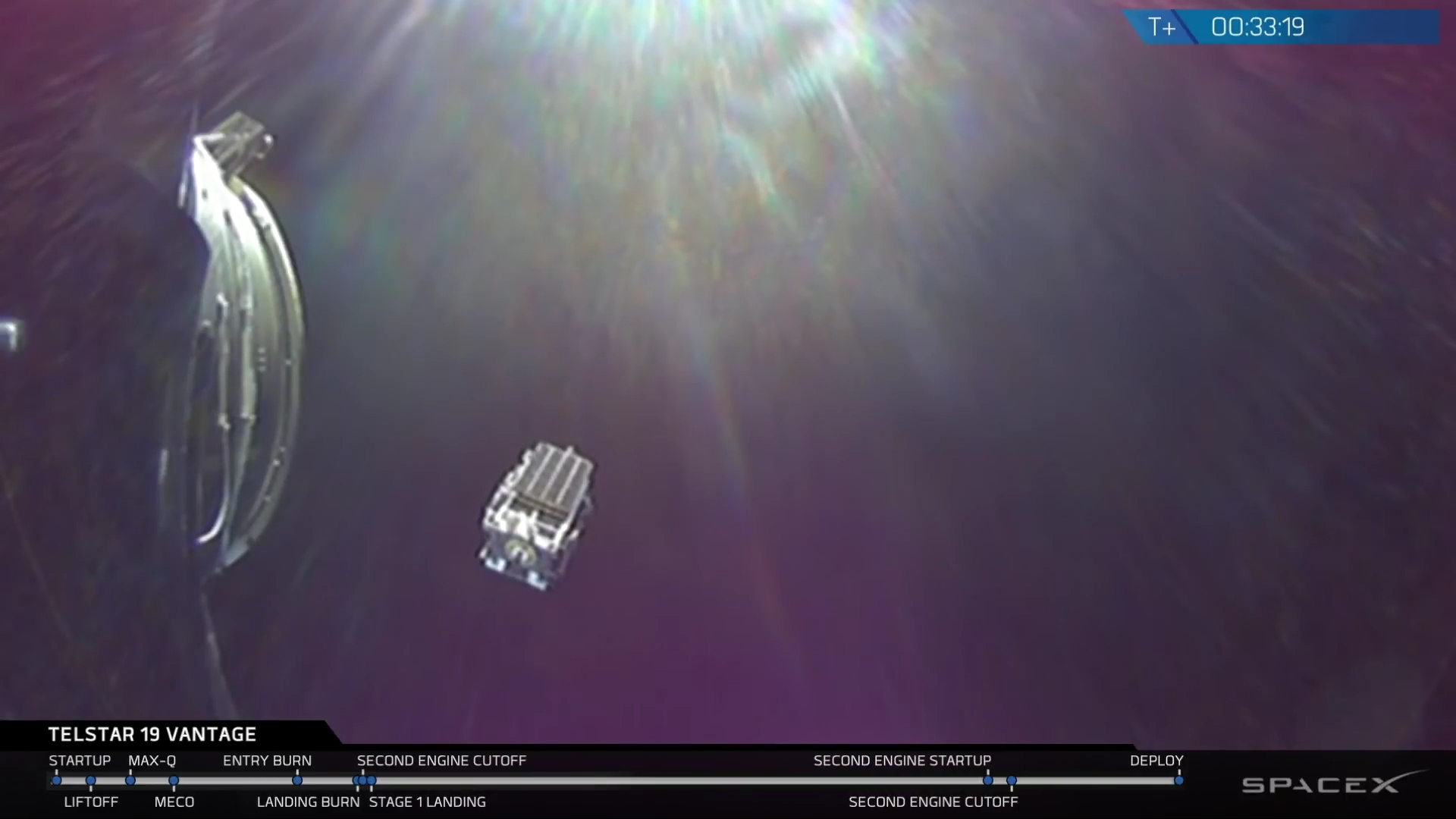Do you remember the launch of Bangabandhu-1? It was the first launch of the latest version of the Falcon 9: the Block 5! On Sunday, July 22, 2018, it was the turn of the Telstar 19V satellite to take off aboard a Block 5, the second one produced and launched by SpaceX. The launch took place at 7:50 French time and in the Florida night (1:50) from launch pad 40 at Cape Canaveral.

Telstar 19 VANTAGE
Telstar 19V is a new satellite commissioned by the Canadian company Telesat and built by the American company SSL (Space Systems Loral). It has joined Telstar 12V and Telstar 18V in orbit. The purpose of these different satellites is to provide optimal and flexible coverage for satellite operators. With the rapidly increasing communication needs of individuals, governments, businesses, and even in the maritime and aerospace industries, there is a need for increasingly efficient means of information transmission.

Telstar 19V carries two payloads: Ku-band and Ka-band antennas. It orbits very close to its counterpart, Telstar 14R, in geostationary orbit (36,000 km altitude) at a longitude of 63° West. This location is highly convenient as it allows direct communication with both North America and Europe. Telstar 19V brings enhanced communication capabilities to North America with High Throughput Satellite (HTS) signals in Ku and Ka bands. Additionally, this new satellite introduces HTS signals to Brazil, the Andean region, the Caribbean, and northern Canada.

Telstar 19 Vantage is expected to operate for about fifteen years in its orbit before being propelled to a graveyard orbit, slightly farther from Earth than the geostationary orbit it occupied, both to free up its position and to prevent it from becoming uncontrollable and colliding with other satellites. It also becomes the heaviest commercial satellite ever launched into Geostationary Transfer Orbit (GTO), with a mass of 7,080 kg, surpassing the previous record held by TerreStar1, another satellite built by SSL, launched in July 2009 aboard an Ariane 5 and weighing 6,910 kg.

However, Telstar 19V will not reach its final orbit with this mass. Indeed, the Falcon 9 that launched it placed it in a relatively low orbit: 243 km by 17,863 km and inclined at 27.0°. Even though this orbit is far from the typical GTO (closer to 400 km by 36,000 km), neither SpaceX nor Telesat seemed sad, indicating that this orbit is indeed the one expected. To reach the final geostationary orbit, Telstar 19V will have to use the onboard fuel (hydrazine).
Launch

This flight, in addition to marking a new record for mass, represents the second flight of the Falcon 9 Block 5, the latest iteration of this launcher. After a perfect launch on May 11, 2018, detailed here, this flight encountered a very slight issue that made some sweat. Indeed, the entire first phase of the flight proceeded perfectly: liftoff on time, passing through the supersonic and Max-Q phases without issue, stage separation without hiccups, and completion of the first stage’s burn (we’ll come back to what happened to the first stage just after). After a 18-minute cruise phase, the second stage was supposed to reignite its Merlin engine for 50 seconds to push the orbit’s apogee and reduce its inclination. The reignition went very well, but a few seconds before the planned shutdown, one of the engineers announced “Low Signal” and no one spoke on the live feed. This message simply means that the signal received from the second stage is too weak. This problem often occurs when a launcher passes from one ground station to another. At that moment, it is at the farthest point from an antenna, and the signal becomes weak. However, during this flight, the Low Signal message was announced while the second stage was above the ground station in Benin, so there was no apparent reason for the signal to be so weak. This incident is usually not a problem, but here, it appeared just before the engine shutdown. Thus, the engineers at Hawthorne, SpaceX’s headquarters, had no way to confirm the engine shutdown. Fortunately, a minute after the signal loss, it returned, and the orbit was confirmed to be correct: the engine shut down at the right time!

On the other hand, the first stage didn’t let itself be abandoned. After the separation of the two stages, it flipped around to prepare for reentry into the atmosphere. 3 minutes and 30 seconds later, once the air density increased, three engines reignited on the booster to slow it down and prevent it from overheating too much. Another positive aspect of this reignition is that the flames from the three thrusters form a sort of plasma shield that provides even more protection to the stage. After this brief reignition, there was a waiting phase of about 1 minute and 30 seconds. Finally, the central engine of the stage ignited to slow it down and land it on the OCISLY (Of Course I Still Love You) drone ship, which was waiting off the coast of Florida in the Atlantic.

In summary, this launch was another success, marking the 13th Falcon 9 flight this year. It set a record for GTO payload mass, increased the reliability of the Block 5, improved satellite communication in America, and tested the nerves of engineers and spectators with the slight signal loss from the second stage.




